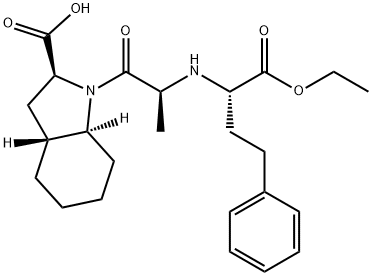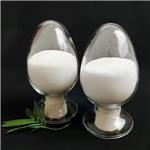Description
Trandolapril is a new ACE inhibitor that is rapidly hydrolyzed, mainly in the liver, to its
biologically active form, trandolaprilat. Compared with all other ACE inhibitors, trandolaprilat is
reported to have the highest lipophilicity and the most prolonged ACE inhibitory activity. In
hypertensive patients, trandolapril at a dose of 2 mg reduces blood pressure consistently
throughout the 24 hour period after intake, making it one of the best once a day
antihypertensive drugs. It has also been demonstrated to inhibit aortic atherosclerosis in the
hyperlipidemic rabbit.
Chemical Properties
White or almost white powder.
Originator
Roussel Uclaf (France)
Uses
An antihypertensive. Angiotensin converting enzyme (ACE) inhibitor
Uses
Trandolapril has been used as an angiotensin-converting enzyme (ACE) inhibitor to study its effects on responsiveness of human retinal endothelial cells (HRECs) to vascular endothelial growth factor (VEGF).
Definition
ChEBI: Trandolapril is a heterobicylic compound that is (2S,3aR,7aS)-1-[(2S)-2-aminopropanoyl]octahydro-1H-indole-2-carboxylic acid in which the hydrogen of the amino group is substituted by a (2R)-1-ethoxy-1-oxo-4-phenylbutan-2-yl group. It is a angiotensin-converting enzyme inhibitor and a prodrug used for the treatment of hypertension. It has a role as a prodrug, an antihypertensive agent and an EC 3.4.15.1 (peptidyl-dipeptidase A) inhibitor. It is a dicarboxylic acid monoester, a dipeptide, an ethyl ester, a secondary amino compound, a tertiary carboxamide and an organic heterobicyclic compound. It is functionally related to a trandolaprilat.
brand name
Odrik; Udrik; Gopten
General Description
Trandolapril, 1-[2-(1-ethoxycarbonyl-3-phenylpropylamino)propionyl]octahydroindole-2-carboxylicacid (Mavik), is an indole-containing ACE inhibitorthat is structurally related to most of the precedingagents discussed. Enalapril is very similar to trandolapril,with the primary difference occurring in the heterocyclicsystems. The pyrrolidine of enalapril has been replacedwith an octahydroindole system. Much like enalaprilate,trandolapril must be hydrolyzed to tranolaprilate, which isthe bioactive species.
Biochem/physiol Actions
Trandolapril is an ACE inhibitor. Trandolapril differs from other ACE inhibitors in that it has a longer biological half-life and a high degree of lipophilicity.
Clinical Use
Angiotensin converting enzyme inhibitor:
Hypertension
Heat failure
After myocardial infarction
Drug interactions
Potentially hazardous interactions with other drugs
Anaesthetics: enhanced hypotensive effect.
Analgesics: antagonism of hypotensive effect and
increased risk of renal impairment with NSAIDs;
hyperkalaemia with ketorolac and other NSAIDs.
Antihypertensives: increased risk of hyperkalaemia,
hypotension and renal failure with ARBs and
aliskiren.
Bee venom extract: possible severe anaphylactoid
reactions when used together.
Ciclosporin: increased risk of hyperkalaemia and
nephrotoxicity.
Cytotoxics: increased risk of angioedema with
everolimus.
Diuretics: enhanced hypotensive effect;
hyperkalaemia with potassium-sparing diuretics.
ESAs: increased risk of hyperkalaemia; antagonism
of hypotensive effect.
Gold: flushing and hypotension with sodium
aurothiomalate.
Lithium: reduced excretion (possibility of enhanced
lithium toxicity).
Potassium salts: increased risk of hyperkalaemia.
Tacrolimus: increased risk of hyperkalaemia and
nephrotoxicity.
Metabolism
Trandolapril is metabolised in the liver to the active
trandolaprilat and to some inactive metabolites. About
33
% of an oral dose of trandolapril is excreted in the
urine, mainly as trandolaprilat; the rest is excreted in the
faeces.




